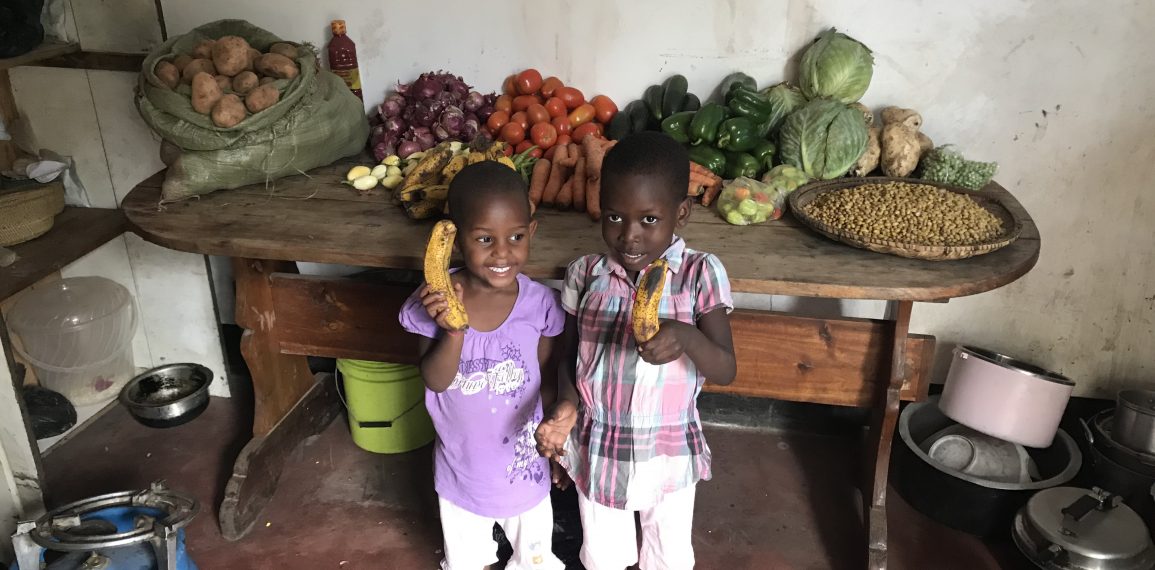Favorite meal: chicken – Shopping, eating and cooking at Hope Home
Shopping is always a little adventure for Sarah and Joseph. There are no well-stocked, air-conditioned supermarkets as we know and appreciate them in the rural areas of Tanzania – as in Boma Ng’ombe. Purchases are therefore made at local markets, which change location daily. And so on some days Sarah and Joseph simply have to take a more than one hour bus ride to the next market, including a change of trains.
Since there is no refrigerator in the Hope Home and the food spoils quickly in the Tanzanian heat, the two of them set off several times a week on their arduous way. Sarah and Joseph always take care to provide the children with a healthy and balanced diet. What ends up in the shopping bag, however, depends on how much money they have at their disposal. The cheapest are beans, rice and Ugali, a cereal porridge made from corn flour. There are also regular fruit and vegetables. Fish, meat and eggs, on the other hand, are expensive foods and are therefore only on the menu in exceptional cases. To feed a child in Tanzania costs an average of about 1,300 Tanzanian shillings per day – the equivalent of about 50 euro cents.
Cooking takes place at least once a day, usually twice a day. The older girls in the Hope Home help diligently and passionately to cook a delicious meal for all children. The preparation is complex and usually takes several hours. The children’s favourite food, by the way, is very similar to our own at first glance: noodles with chicken. Since the ingredients for this are expensive, the favourite dish is only served on very special occasions. Toast and jam are also absolute highlights on the children’s menu. Cheese, sausage and butter are just as little on the average Tanzanian menu as muesli and rolls. In Tanzania, people traditionally eat with their fingers – with the right hand, since the left is considered unclean. After the meal, the dishes are rinsed by hand – and everyone helps diligently.
We were also able to help with the cooking during our visits. Denise is particularly proud of her stew of chicken heads and innards and was able to inspire the Tanzanians with her minced meat stew during her last visit – despite their amazement at the very suspicious way of preparation (quote: “I’ve never seen anyone cook like this before.”).
Here we have put together some pictures and information about regional fruit, vegetables, spices and traditional dishes:
– Bananas are among the most important foods in Tanzania and are not only picked fresh and eaten raw as fruit, but are also prepared in a variety of ways: fried, roasted, grilled or roasted.
– In Tanzania we saw for the first time a red pineapple, a colourful, exotic plant with tender red flesh.
– The jackfruit can weigh up to 35 kilos. Its milky juice has a highly sticky consistency. It tastes like a mix of pineapple and banana – simply delicious!
– Ugali is a cereal porridge made from corn flour that is cooked relatively firmly and resembles the consistency of potato dumplings. It is the basis of your diet because it is inexpensive and satiating. It is usually eaten unseasoned as a side dish with stews, fish or meat. Detailed information: Ugali
– Kitumba, roasted bread, and Chapati, flat bread, are often sold on the roadside as snacks.
– Mandasi are small balls of dough that resemble donuts.
– Pilau is a rice dish prepared with many spices such as cloves, cardamom, cinnamon and pepper and optionally served with beef stomach. Would you like to test the taste of Pilau for yourself? Here you can find a recipe
– Chipsi mayai: Tanzanian “chips” are made from potatoes, which are then fried in a pan with eggs, carrots and cabbage. Pili pili – a homemade spicy sauce – is eaten with this potato omelette. Otherwise, cabbage vegetables and chilli sauce are often served: More detailed information can be found here
– Samosa are triangular, crispy fried dumplings made from a kind of strudel dough. They are filled with potatoes or minced meat and are sold on almost every street corner as fast food. Would you like to cook Samosas yourself? http://www.tasteoftravel.at/samosas/
Which one would you prefer?




